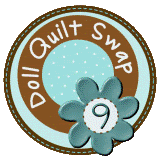I'm calling this block the Squished Nine Patch. I'm sure it has an official name--maybe two or three like many traditional blocks--but, I don't know any of them, so you get this one. :) My quilt will end up being queen sized with a border, which will require 72 squares, but you don't need to make one that big. I hope you like this block--I do. It's quick, easy and not something you have to think over--you can just sew away!
 |
| Original vintage block on the left. My version on the right. |
This block was created off of a set of vintage/antique hand sewn blocks I mentioned earlier in the blog. Those blocks measured 9 3/4 inches--not exactly an easy number to start figuring piecing from. So my version measures 10 inches finished. Way easier! You can piece each part individually, but I chose to strip piece for a quicker version. I'll give you measurements for individual pieces though, just in case you're working with smaller scraps. Warning: This tutorial might seem long and involved, but really...it's just a lot of photos taking up space. But, I like to make sure you can see exactly what I'm explaining, so no worries--it really, really is quick to put together!
For this block you only need two different fabrics. I chose dark navy and indigo blues contrasted with a salmon pink.
 |
| Each block starts with these pieces. |
Strip piecing measurements:
2 blue strips 4.25 x 9 inches
1 blue square 3 inches
2 pink strips 3 x 9 inches
Individual piecing measurements:
4 blue squares 4.25 inches
1 blue square 3 inches
4 pink rectangles 3 x 4.25 inches
All seams are a scant 1/4 inch. I used a navy thread, but any neutral or matching thread will work fine.
Step One:
Take one of the pink strips, lay it horizontally and cut in half. You should now have two 3 x 4.5 inch rectangles.
Step Two: Match the blue square to one pink rectangle, right sides together, aligning them on the 3 inch side of the rectangle. Take the other pink strip and one blue strip, right sides together, aligned along one of the long sides.
Step Three: Sew along the short side of the rectangle/square combo and along the long side of the strip combo. You can see my dark thread line below.
Step Four: Set seams by first pressing flat and then press open. Press seam allowances towards the blue fabric.
See how the seams go towards the blue fabric--this will be important later for accurate alignment.
Step Five: Now attach the other pink rectangle to the other side of the blue square. Also sew the other blue strip to the other long side of the pink strip.
Again, see the thread line below--it clearly shows you which side to sew along.
Step Six: Set seams and press seam allowances towards the blue fabric.
Your seam allowances in each section will be opposite because you've pressed them towards the blue fabric on each one.
Step Seven: Set the skinny strip aside. Take the larger section and cut in half vertically. You will now have two matching fatty strips that are 4.25 inches wide each consisting of two blue squares with a pink rectangle in the middle.
Step Eight: Space the two fatty strips apart with the skinny strip now in the middle like this.
Step Nine: You will now place the skinny strip, right side down, on the fatty strip to the left. Align the strips at the seams (where the white arrows are pointing). They should just settle right into place because of the seams being in opposite directions.
See how they just line right up and kind of nestle in place. This will help you get nice, accurate points on your corners. Very important. I like to add a couple of pins to the sides of the seam to hold them in place until I sew them.
Step Ten: Sew down the vertical length of these strips like this.
Step Eleven: Set seam and press seam allowance towards the fatty strip.
Step Twelve: You should now have two sections--a big fat one and one of the remaining fatty strips (the one that was on the right of the skinny strip earlier.) Take this remaining fatty strip and attach it to the big section, aligning it on the right side of what was previously the center skinny strip. Set seams and press seam allowance towards the fatty strip.
Once pressed open, your block should look like this. It's almost finished. Can you see the "squished" squares of the nine patch?
Your block should line up so that the center, where all the corners meet, is all aligned with all corners at ninety degrees and level--no wonkiness or overlapping desired! (See the white arrows below.)
 |
| Look at those perfect corners and center square--that's what you're looking for! My seams really are straight, despite the photo. Take your time to get great results. |
Step Thirteen: Your final step is simply to square up your block to 10.5 inches. Align from the center of the block in order to assure that your center square is in the actual center of your block and not slightly to one side.
Ta Dah! Pretty quick wasn't it? I'll bet you can sew these blocks up faster than you can read this tutorial!
Have fun making the Squished Nine Patch!



































































